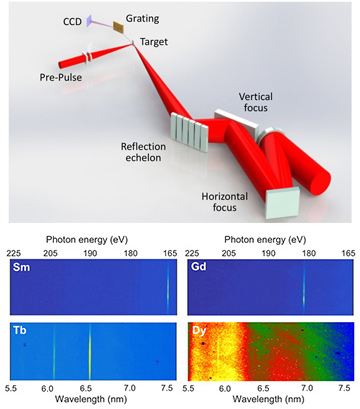 Top: Schematic representation of X-ray laser experimental setup. Bottom: End-on plasma column spectra showing lasing at progressively shorter wavelengths in the 4d1 S0-4p1 P1 line of nickel-like lanthanide ions, down to λ = 5.85 nm in nickel-like dysprosium. [Enlarge figure]
Top: Schematic representation of X-ray laser experimental setup. Bottom: End-on plasma column spectra showing lasing at progressively shorter wavelengths in the 4d1 S0-4p1 P1 line of nickel-like lanthanide ions, down to λ = 5.85 nm in nickel-like dysprosium. [Enlarge figure]
The need for bright, energetic ultrafast X-ray laser pulses has motivated the commissioning of X-ray free-electron lasers. Plasma-based X-ray lasers can also support many experiments requiring bright, high-energy X-ray laser pulses, such as single-shot nanoscale imaging in compact facilities.
These lasers provide extremely monochromatic radiation (typically Δλ/λ = 3 × 10–5) and, when injection-seeded, can reach full spatial and temporal coherence. But compact repetitively fired gain-saturated X-ray lasers have been limited to wavelengths above 8.85 nm.1 We have extended compact plasma-based X-ray lasers to wavelengths of 6.85 nm, through transient traveling-wave excitation of nickel-like gadolinium ions in a dense plasma.2
The X-ray lasers were excited by irradiating solid slab targets with a sequence of two laser pulses from an 800-nm chirped-pulse amplification Ti:sapphire laser. The first pulse, or pre-pulse, ionizes the plasma to the vicinity of the nickel-like ionization stage. A subsequent sub-picosecond pump pulse, impinging at grazing incidence, rapidly heats the electrons to produce a transient population inversion by collisional electron impact excitation.
We optimized the pre-pulse duration to maximize laser output, finding that the best lasing occurred when the pre-pulse has a FWHM duration of around 185 ps. The delay between the pre-pulse and pump pulse controls the plasma density and density gradient in the gain region, as well as the degree of ionization (that is, the fraction of nickel-like ions) at the time of excitation by the sub-picosecond pump pulse. The maximum laser output intensity comes when the pump pulse arrives at the target roughly 30 ps after the peak of the pre-pulse.
Isoelectronic scaling also produced strong lasing at 6.67 nm and 6.11 nm in nickel-like terbium, and amplification at 6.41 nm and 5.85 nm in nickel-like dysprosium. We obtained this scaling to shorter wavelengths by progressively increasing the pump pulse grazing incidence angle to access increased plasma densities. We experimentally demonstrated that the optimum grazing incidence angle increases linearly with atomic number, from 17 degrees for Z = 42 (molybdenum) to 43 degrees for Z = 66 (dysprosium). The results, we believe, will enable applications of sub-7-nm lasers at compact facilities.
Researchers
Alex Rockwood, Yong Wang, Shoujun Wang, Vyacheslav N. Shlyaptsev and Jorge J. Rocca, Colorado State University, Fort Collins, Colo., USA
Mark Berrill, Colorado State University and Oak Ridge National Laboratory, Oak Ridge, Tennessee, USA
References
1. D. Alessi et al. Phys. Rev. X 1, 021023 (2011).
2. A. Rockwood et al. Optica 5, 257 (2018).
